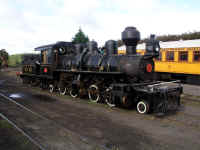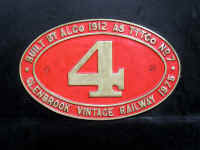 |
 |
The Glenbrook Vintage railway (web site) is 3'6" gauge. This heritage railway operates several ex-logging and ex-NZR locomotives and other equipment on its 10 Km of track. The GVR has good workshop facilities and major steam locomotive overhauls are completed here for other heritage rail groups. An ALCO Mallet 2-4-0 0-4-2, the only one in the world still operates here.
The Mallet (2-4-0 0-4-2) waiting in the yard for an assignment that comes all too
infrequently these days ...
Glenbrook's well equipped shop in the midst of a locomotive restoration. Photos 7 and 8 are of the piston valve and cylinder bores respectively.
A typical fuse/breaker panel used in New Zealand. The fuses/breakers
are surface mounted on a Tufnol (like bakelite) board with the wires fed
through from the rear. US electrical code inspectors would probably
shudder at the sight but it seems to work for folks here.
1250, the beautiful "J" class (4-8-2) locomotive that will be pulling our
train out of Glenbrook.
Our coach ...
Some shots of the Glenbrook yard as we depart. A couple of interesting cranes, a
'double slip' or 'puzzle' switch as well as some stacks and drivers in search of
a locomotive ...
Shortly after starting out we stopped at the water tower to blow down the
boiler. Rex (standing on the ground, center photo) was one of our tour
'staff photographers' (along with Mike Orange). Rex was surprised when,
after the blowdown, we departed instead of taking on water. He had to
hustle to re-board the train ...
Part way through the run they let us off at a level crossing and backed up to
do two photo run-bys.
After the photo run-bys we noticed that there were some interesting flowers nearby.
The tree in the lower left photo is a "Cabbage" tree (tall one on
the right).
We then continued on through more beautiful New Zealand countryside.
The windbreaks shown in the last photo are common here. Most of the windbreaks
have branches all the way down to the ground. I don't know why these
didn't.
Joan checking out the cylinders and drivers on our locomotive and giving you
an idea of the locomotive's size as it couples to the rear of the train for the
return trip to Glenbrook.
Buildings in Glenbrook yard ...
Joan says I can't get up in the morning without getting dirty, never mind
poking around a steam locomotive - hard to see here, but I have a large black
smear on the left side of my nose!
Phil, one of the owners of Piako Ostrich Farm (web
site), is showing how they 'blow' an ostrich egg. With a
cordless drill, he drilled a hole about 3/8" diameter in one
end. He then shook the egg over a pitcher. The result was an amazing
amount of egg - over a liter, equivalent to about two dozen hen's eggs.
Periodically the eggs in the nest must be turned.
One thing we were warned about was not to stand too close to the fence
because the ostrich has a very powerful kick. How'd you like to get kicked
in the chest with these toes!
They have ostriches from very small to full grown. Since they 'imprint' on the first person they see when they are born (in this case Phil), they follow him around whenever he enters the pen.
In the afternoon we traveled to the Thames Small Gauge Railway Society (web site). Their site is located alongside the bay in Thames. After initially checking out the track site, Joan, Elaine and several others went bird watching at a bird hide (bird blind gazebo) located near the track. They had the opportunity to view several shorebird species up close.
While Joan and Elaine were off doing their thing, Larry and I enjoyed the hospitality of the club, including riding as well as driving (running a loco). The track was an elongated loop with a crossover forming a figure eight.
On the left is a unique engine but I didn't get details. On the right
is Gavin McCabe's #66.
This little handcar was keeping the kids busy. On the left is a photo
of the works.
Notice the huge axle on this riding car. I never located the owner to
find out why the axle was so large.
Relaxing at Grahamstown station (the clubhouse ...) before dinner.
The club served us Peas, Pie & Pud (peas, meat pie & potatoes) for
dinner. This was a typical meal people
would pick up when a train would stop in a town. It could easily be eaten while
riding the train.
Across the street from the rail club was the School of Mines Museum. The main part of the museum consisted of a room mostly containing displays of rock samples. There were, however, several models of mining equipment, 'timbering' techniques, etc. When we were ready to leave, the gentleman there said that if we came back at 4:00 he would take us through the 'battery room' which was in another building not normally open to the public. We also learned that his father had worked at the School of Mines and had a part in preserving it.
When we came back at 4:00 to check out the battery room visions of switch panels and meters danced in our heads. Much to our surprise the 'battery room' turned out not to contain electric 'batteries' as we were expecting but rather was a room that had at one time contained a small 'stamping battery' ('stamping mill' to us) used to pound the gold ore to small particles prior to undergoing the gold separation process.
The remains of the stamping mill were of some interest but, of more interest to Larry and me was the room next door which contained a Pelton Wheel water turbine. Apparently they used this method of generating power because the water supply was free since it was brought down from the hills close by. He said that at one time there had been a dynamo connected to the turbine via a flat belt but that the dynamo had been lost.
While poking around the room Larry and I came across a pile of 'stuff'
that we immediately recognized as being the parts to a dynamo. Apparently this
was the 'lost' dynamo but he had not realized what the collection of parts
was. Apparently it had been disassembled. The armature had been removed but was
still present (front
item the photos). It's obviously in need of restoration but looks to
be complete. He was very pleased that we had solved that mystery for him ...
Another interesting item was this old blueprint machine his father had
used. The black item at the top is an arc lamp used to expose the blueprint
which is held in position on the glass cylinder at the bottom.
This was an interesting model of a deep well pump section. A complete well pump consisted of several of these sections at intervals down a vertical shaft all operated by a steam engine driven pump rod. Each section would dump its water into the intake box of the pump above. The photos are of the complete pump section, the bottom section, the middle section, the upper section and a closer view of the valve section in the center.
Also in the building was the ever present hot water maker. We're not sure if
this was just hot water for the sink or if it made water hot enough for tea,
etc.
The Tuscany On Thames motel was extremely neat and comfortable. We were served breakfast in our rooms each morning and could enjoy the Jacuzzi (one in each room!) each night.
Some of us took the opportunity to enjoy a swim in the pool that evening.
Next day: January 5th